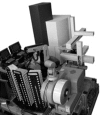Rapid identification of emerging infectious agents using PCR and electrospray ionization mass spectrometry
- PMID: 17470915
- PMCID: PMC7167958
- DOI: 10.1196/annals.1408.008
Rapid identification of emerging infectious agents using PCR and electrospray ionization mass spectrometry
Abstract
Newly emergent infectious diseases are a global public health problem. The population dense regions of Southeast Asia are the epicenter of many emerging diseases, as evidenced by the outbreak of Nipah, SARS, avian influenza (H5N1), Dengue, and enterovirus 71 in this region in the past decade. Rapid identification, epidemiologic surveillance, and mitigation of transmission are major challenges in ensuring public health safety. Here we describe a powerful new approach for infectious disease surveillance that is based on polymerase chain reaction (PCR) to amplify nucleic acid targets from large groupings of organisms, electrospray ionization mass spectrometry (ESI-MS) for accurate mass measurements of the PCR products, and base composition signature analysis to identify organisms in a sample. This approach is capable of automated analysis of more than 1,500 PCR reactions a day. It is applicable to the surveillance of bacterial, viral, fungal, or protozoal pathogens and will facilitate rapid characterization of known and emerging pathogens.
Conflict of interest statement
All authors are full‐time employees and stockholders of Ibis Biosciences, Inc., a wholly owned subsidiary of Isis Pharmaceuticals, Inc.
Figures


References
-
- Wong, K.T. et al 2002. Nipah virus infection, an emerging paramyxoviral zoonosis. Springer Semin. Immunopathol. 24: 215–228. - PubMed
Publication types
MeSH terms
LinkOut - more resources
Full Text Sources
Other Literature Sources
Medical
Miscellaneous

